Table of Contents
Overview
Neuquen Basin Shale Play Activity
Shale Gas and Light, Tight Oil Production Results
3D Maps
EIA Overview
The Argentina government has made the development of the
shale resources of the country a priority since a EIA report
came out with a league table ranking showing Argentina with the
second highest shale gas resource potential and the fourth
highest oil resource potential. This suggested at least
the possibility of billions of barrels of oil and trillions of
cubic feet of natural gas that might be available to Argentina
for internal use and export. For a country struggling
under a variety of financial burdens, this potential was
extremely enticing, and led to a significant government effort,
up to and including the renationalization of YPF, the national
oil company, to encourage both directly and indirectly the
exploitation of these resources.
At the direction of multiple clients, The Energy Consulting
Group has done extensive work studying and evaluating the shale
and light, tight oil potential of Argentina, including the
ongoing efforts to convert the non-conventional resource
potential into useable oil and gas product streams. Below
we have presented a small sampling of this large body of work,
to provide the casual observer with some sense as to the status
of this national effort. If interested, please contact us
at
insight@energy-cg.com
for more detail.
Overview
Per the EIA, Argentina has some of the largest shale oil and gas
potentially recoverable resources in the world.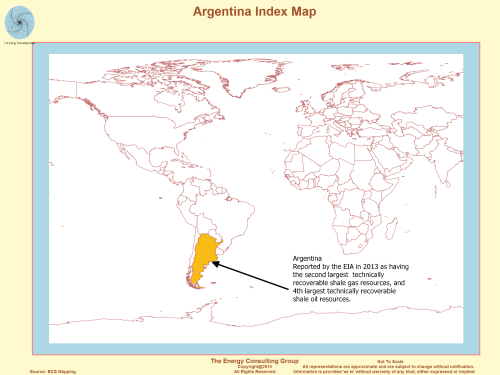
For Higher Resolution, Click Image |
Estimated Technically Recoverable Shale Oil Resource By Country

For Higher Resolution, Click Image
For Higher Resolution, Click Image |
|
Estimated Technically Recoverable Shale Gas Resource By
Country
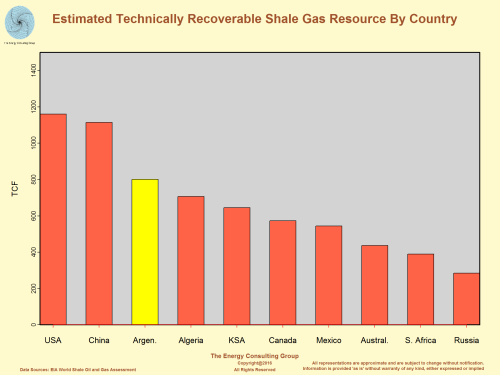
For Higher Resolution, Click Image |
Argentina Oil Production and Reserves as Reported in the
BP Statistical Survey

For Higher Resolution, Click Image |
Argentina Gas Production and Reserves as Reported in the
BP Statistical Survey
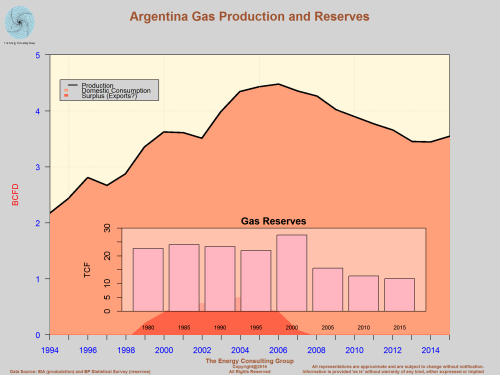
For Higher Resolution, Click Image |
|
Neuquen Basin Shale Play Activity
Neuquen Basin, Argentina
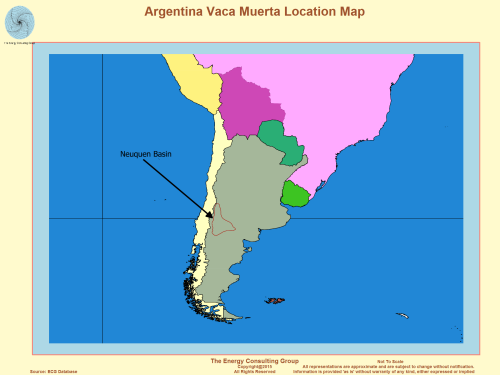
For Higher Resolution, Click Image |
Vaca Muerta Potential Fluid Types
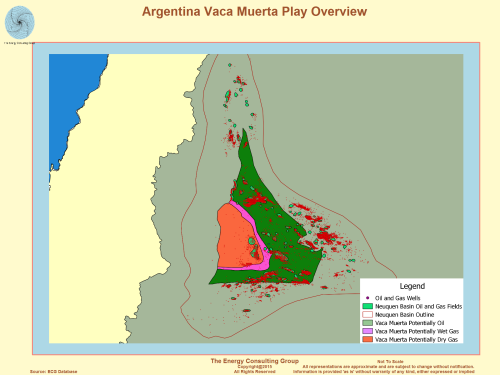
For Higher Resolution, Click Image |
Production Results
The Energy Consulting Group has compiled
the production histories of all the shale and light,
tight oil wells drilled in Argentina, which are now approaching
600 in total number, and include both vertical and horizontal
completions. This gives us the capability to assess both
the economics of shale efforts, but also the technical efficacy
of the different well and fracking designs being utilized.
Below are four examples of shale well results, two each from the
Vaca Muerta and Mulichinco plays (we have temporarily removed
the axis values). What is apparent from our analysis is
that the production results are steadily improving, and are now
approaching, and in some cases, equaling North American shale
production results. That said, wells costs and fiscal
terms are subtantially different from the North American
counterparts, so the well level economics are lagging.
This example reflects one of the more successful
Vaca Muerta horizontal
completions.

For Higher Resolution, Click Image |
This example reflects that the
Vaca Muerta is also capable of significant gas
production.
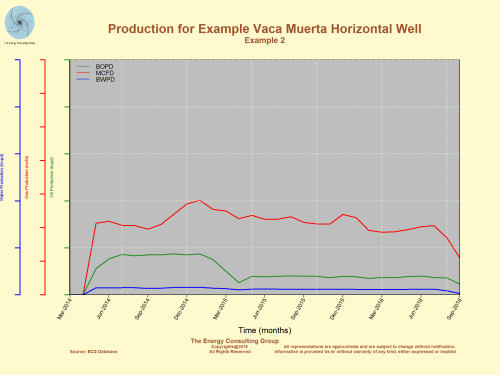
For Higher Resolution, Click Image |
Mulichinco
horizontal shale wells are capable of delivering solid
production results, though not all do so.
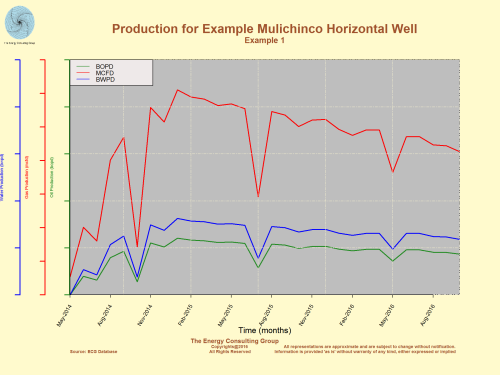
For Higher Resolution, Click Image |
As with all shale plays, there are a range of
production results.
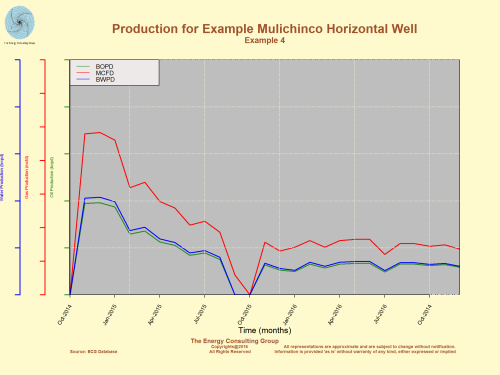
For Higher Resolution, Click Image |
| |
|
| |
|
| |
|
| |
|
3D Maps
The following panel contains an interactive 3d elevation map of the
Neuquen Basin region.
This is intended to provide a quick way of visualizing how the
surface topography of the Neuquen increases the costs and challenges of
exploiting oil and gas resources, including the shale/tight plays as
activity, going from east to west.
(source: EIA)
Link to EIA
article
Last Updated: March 2016
EIA Overview
Map of Argentina
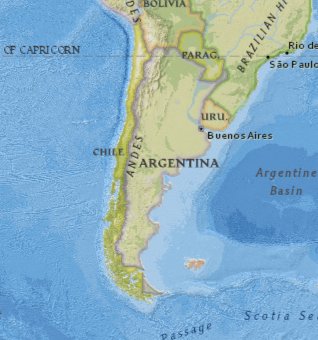
- In 2014, Argentina was the largest dry gas producer and
the fourth largest petroleum and other liquids producer in
South America.
- Argentina’s new hydrocarbons reform, published on
October 31, 2014, provides investors with offshore
exploration opportunities and encourages foreign ventures in
unconventional plays. Before the 2014 reform to the 1967
Hydrocarbon Law, Argentina’s energy sector policies prompted
an imbalance of energy supply and demand by limiting the
industry’s attractiveness to private investors, restraining
the profits of domestic producers, and shielding consumers
from rising prices. Domestic demand for energy grew rapidly
while production of both petroleum and other liquids and
natural gas declined – making Argentina a net hydrocarbons
importer.
- To incentivize foreign investment in the hydrocarbons
sector and boost domestic energy supplies policy reforms
have changed the national bidding process, increasing the
frequency of offshore licensing rounds, allowing for longer
exploitation periods, and offering tax exemptions to
companies that invest more than $250 million over a
three-year period.
- To limit the influence of the low oil prices on
production, the Ministry of Economy reduced oil exports
tariffs in 2014.
- The Argentine government provides tax incentives to
companies that form partnerships with state-owned energy
company, Energía Argentina Sociedad Anónima’s (ENARSA), for
offshore exploration and offers higher gas prices for new
gas production sold in the domestic market under the Gas
Plus Plan.
- In Argentina, the energy sector is regulated by the
Ministerio de Planificación Federal, Inversión Pública y
Servicios (Ministry of Federal Planning, Public Investment,
and Services). The Ministry includes the Ente Nacional
Regulador de Gas (ENARGAS), which regulates natural gas
transportation, and distribution activities; and the
Secretaría de Energía (Energy Secretariat), which oversees
upstream oil and natural gas production. The 2014 reform
transferred all of the offshore permits and concessions of
state-owned energy company ENARSA’s to the Energy
Secretariat.
- According to the 2014 Energy Balance published by the
Argentina’s Energy Secretariat, total primary energy
production in Argentina was 3.35 quadrillion Btu. Natural
gas production accounted for approximately 51%, and
production of crude oil represented 37% of the total energy
production portfolio. Hydroelectricity is the third largest
primary energy source.
- Natural gas, which is used widely in the electricity,
industrial, and residential sectors, represented 52% of
total primary energy consumption in 2014 (3.34 quadrillion
Btu). Oil is the primary fuel used in the transportation
sector and represented 33% of total primary energy
consumption. A smaller share of the country’s total energy
consumption can be attributed to nuclear, coal, and
hydropower, which are used for electricity generation, while
other renewable resources are used to produce biofuels for
transportation.
Petroleum and other liquids
As of January 2016, Argentina held 2.4 billion barrels
of proved crude oil reserves according to Oil and Gas
Journal (OGJ). In 2015, total oil production was
716,000 barrels per day (b/d), of which 513,000 b/d was from
crude oil and 108,000 b/d was from natural gas plant
liquids.
YPF is the largest oil producer in the country and
extracts oil from about 59 fields. The second-leading oil
producer, with 19% for total production in 2014, is Pan
American Energy (PAE), which is owned by BP and the Bridas
Corporation (a 50-50 joint venture between the China
National Offshore Oil Corporation and Bridas Energy
Holdings). PAE currently operates one of Argentina’s largest
oil fields, the Cerro Dragón field. Chevron (U.S.),
Petrobras (Brazil),
and Sinopec Group (China)
also have had a significant presence in Argentina’s upstream
oil production.
Argentina has ten refineries with a combined 634,000 b/d
of crude refining capacity, more than half of which is
controlled by YPF, according to the OGJ.
Argentinian refined products do not satisfy all domestic
fuel demand. As a result, Argentina imported 91,813 b/d of
total oil products, including 63,000 b/d from the United
States, in 2015.
In November 2013, the European Union (EU), Argentina’s
largest biodiesel export market, implemented anti-dumping
tariffs on biodiesel imports. In January of 2015, the U.S.
Environmental Protection Agency (EPA) approved the import of
biodiesel from Argentina for fuel use, a move that may help
the country recover from the EU tariffs. However, in the
fourth quarter of 2015, total biodiesel exports were down
33% year on year.
Natural gas
Argentina had proved natural gas reserves of
approximately 11.7 Trillion cubic feet (Tcf) in January
2016, according to latest estimates from OGJ, an increase of
0.6 Tcf from 2015. Argentina holds the world’s
second-largest shale gas reserves. Vaca Muerta, located in
the Neuquen Basin, is Argentina’s largest shale gas play
with an estimated 308 Tcf of dry, wet, and associated shale
gas resources.
According to Argentina’s energy ministry, YPF
—Argentina’s former state owned energy company— was
Argentina’s largest natural gas producer in 2015, accounting
for about 31% of the country’s total domestic supply. Other
significant players in the natural gas sector include Total
Austral, Pan American Energy, Petrobras (Brazil), Tecpetrol
(Argentina), and Apache Energy (U.S.).
Argentina produced 1.25 Tcf of natural gas in 2014
according to BP. The largest-gas producing basins include
Neuquén, Austral, and Noroeste. Together, these three basins
account for roughly 85% of the country’s natural gas
production.
Argentina has 18,598 miles of natural gas pipelines.
Predominant pipelines include Neuba I, Neuba II, and San
Martin, which connect producing provinces in the Neuquén,
San Jorge, and Austral basins (located in the central and
southern parts of the country) with Buenos Aires and other
demand centers.
Bolivia
is the source of virtually all of Argentina’s natural gas
imports via pipeline. In 2014, Argentina imported 203
Billion cubic feet (Bcf) from Bolivia via pipeline. Located
on the Paraná River, the Escobar terminal is Argentina’s
sole LNG terminal. Argentina imported 207 Bcf of liquefied
natural gas in 2014 via the terminal, of which the largest
share of LNG came from
Trinidad and Tobago.
Although Argentina is a net importer of natural gas, it
continues to export natural gas to its neighbors — largely
Chile and, to a
lesser extent,
Uruguay.
Electricity
Argentina consumed 120.9 billion kilowatthours in 2013
and remains the second-largest consumer of electricity in
South America, after Brazil.
Through electrical transmission interconnections with
Brazil, Chile,
Paraguay, and Uruguay,
Argentina imported 18.4 billion kilowatthours in 2014, a
130% increase from electrical energy imports in 2013 (8.0
billion kilowatthours), to meet increasing domestic
electricity demand.
The Energy Consulting Group home page
|











